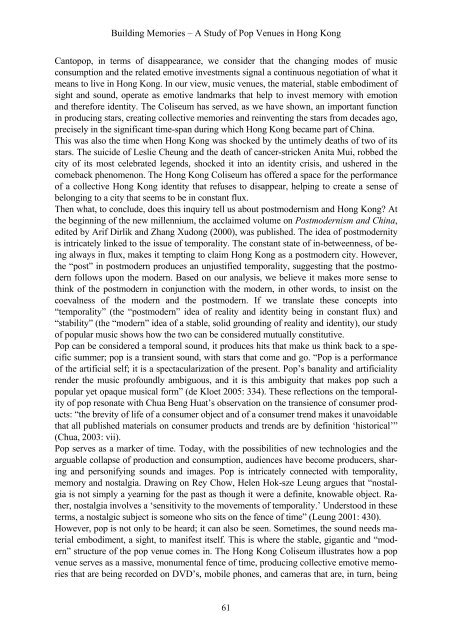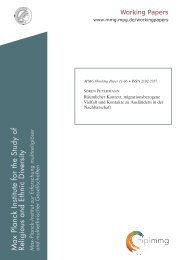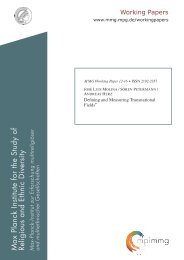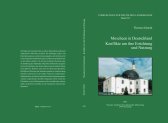Building Memories – A Study of Pop Venues in Hong Kong
Building Memories – A Study of Pop Venues in Hong Kong
Building Memories – A Study of Pop Venues in Hong Kong
You also want an ePaper? Increase the reach of your titles
YUMPU automatically turns print PDFs into web optimized ePapers that Google loves.
<strong>Build<strong>in</strong>g</strong> <strong>Memories</strong> <strong>–</strong> A <strong>Study</strong> <strong>of</strong> <strong>Pop</strong> <strong>Venues</strong> <strong>in</strong> <strong>Hong</strong> <strong>Kong</strong><br />
Cantopop, <strong>in</strong> terms <strong>of</strong> disappearance, we consider that the chang<strong>in</strong>g modes <strong>of</strong> music<br />
consumption and the related emotive <strong>in</strong>vestments signal a cont<strong>in</strong>uous negotiation <strong>of</strong> what it<br />
means to live <strong>in</strong> <strong>Hong</strong> <strong>Kong</strong>. In our view, music venues, the material, stable embodiment <strong>of</strong><br />
sight and sound, operate as emotive landmarks that help to <strong>in</strong>vest memory with emotion<br />
and therefore identity. The Coliseum has served, as we have shown, an important function<br />
<strong>in</strong> produc<strong>in</strong>g stars, creat<strong>in</strong>g collective memories and re<strong>in</strong>vent<strong>in</strong>g the stars from decades ago,<br />
precisely <strong>in</strong> the significant time-span dur<strong>in</strong>g which <strong>Hong</strong> <strong>Kong</strong> became part <strong>of</strong> Ch<strong>in</strong>a.<br />
This was also the time when <strong>Hong</strong> <strong>Kong</strong> was shocked by the untimely deaths <strong>of</strong> two <strong>of</strong> its<br />
stars. The suicide <strong>of</strong> Leslie Cheung and the death <strong>of</strong> cancer-stricken Anita Mui, robbed the<br />
city <strong>of</strong> its most celebrated legends, shocked it <strong>in</strong>to an identity crisis, and ushered <strong>in</strong> the<br />
comeback phenomenon. The <strong>Hong</strong> <strong>Kong</strong> Coliseum has <strong>of</strong>fered a space for the performance<br />
<strong>of</strong> a collective <strong>Hong</strong> <strong>Kong</strong> identity that refuses to disappear, help<strong>in</strong>g to create a sense <strong>of</strong><br />
belong<strong>in</strong>g to a city that seems to be <strong>in</strong> constant flux.<br />
Then what, to conclude, does this <strong>in</strong>quiry tell us about postmodernism and <strong>Hong</strong> <strong>Kong</strong>? At<br />
the beg<strong>in</strong>n<strong>in</strong>g <strong>of</strong> the new millennium, the acclaimed volume on Postmodernism and Ch<strong>in</strong>a,<br />
edited by Arif Dirlik and Zhang Xudong (2000), was published. The idea <strong>of</strong> postmodernity<br />
is <strong>in</strong>tricately l<strong>in</strong>ked to the issue <strong>of</strong> temporality. The constant state <strong>of</strong> <strong>in</strong>-betweenness, <strong>of</strong> be<strong>in</strong>g<br />
always <strong>in</strong> flux, makes it tempt<strong>in</strong>g to claim <strong>Hong</strong> <strong>Kong</strong> as a postmodern city. However,<br />
the “post” <strong>in</strong> postmodern produces an unjustified temporality, suggest<strong>in</strong>g that the postmodern<br />
follows upon the modern. Based on our analysis, we believe it makes more sense to<br />
th<strong>in</strong>k <strong>of</strong> the postmodern <strong>in</strong> conjunction with the modern, <strong>in</strong> other words, to <strong>in</strong>sist on the<br />
coevalness <strong>of</strong> the modern and the postmodern. If we translate these concepts <strong>in</strong>to<br />
“temporality” (the “postmodern” idea <strong>of</strong> reality and identity be<strong>in</strong>g <strong>in</strong> constant flux) and<br />
“stability” (the “modern” idea <strong>of</strong> a stable, solid ground<strong>in</strong>g <strong>of</strong> reality and identity), our study<br />
<strong>of</strong> popular music shows how the two can be considered mutually constitutive.<br />
<strong>Pop</strong> can be considered a temporal sound, it produces hits that make us th<strong>in</strong>k back to a specific<br />
summer; pop is a transient sound, with stars that come and go. “<strong>Pop</strong> is a performance<br />
<strong>of</strong> the artificial self; it is a spectacularization <strong>of</strong> the present. <strong>Pop</strong>’s banality and artificiality<br />
render the music pr<strong>of</strong>oundly ambiguous, and it is this ambiguity that makes pop such a<br />
popular yet opaque musical form” (de Kloet 2005: 334). These reflections on the temporality<br />
<strong>of</strong> pop resonate with Chua Beng Huat’s observation on the transience <strong>of</strong> consumer products:<br />
“the brevity <strong>of</strong> life <strong>of</strong> a consumer object and <strong>of</strong> a consumer trend makes it unavoidable<br />
that all published materials on consumer products and trends are by def<strong>in</strong>ition ‘historical’”<br />
(Chua, 2003: vii).<br />
<strong>Pop</strong> serves as a marker <strong>of</strong> time. Today, with the possibilities <strong>of</strong> new technologies and the<br />
arguable collapse <strong>of</strong> production and consumption, audiences have become producers, shar<strong>in</strong>g<br />
and personify<strong>in</strong>g sounds and images. <strong>Pop</strong> is <strong>in</strong>tricately connected with temporality,<br />
memory and nostalgia. Draw<strong>in</strong>g on Rey Chow, Helen Hok-sze Leung argues that “nostalgia<br />
is not simply a yearn<strong>in</strong>g for the past as though it were a def<strong>in</strong>ite, knowable object. Rather,<br />
nostalgia <strong>in</strong>volves a ‘sensitivity to the movements <strong>of</strong> temporality.’ Understood <strong>in</strong> these<br />
terms, a nostalgic subject is someone who sits on the fence <strong>of</strong> time” (Leung 2001: 430).<br />
However, pop is not only to be heard; it can also be seen. Sometimes, the sound needs material<br />
embodiment, a sight, to manifest itself. This is where the stable, gigantic and “modern”<br />
structure <strong>of</strong> the pop venue comes <strong>in</strong>. The <strong>Hong</strong> <strong>Kong</strong> Coliseum illustrates how a pop<br />
venue serves as a massive, monumental fence <strong>of</strong> time, produc<strong>in</strong>g collective emotive memories<br />
that are be<strong>in</strong>g recorded on DVD’s, mobile phones, and cameras that are, <strong>in</strong> turn, be<strong>in</strong>g<br />
61






